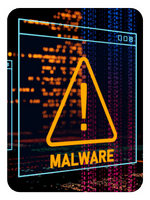6 Top Cybersecurity Threats (& What to Do About Them)
April 25th, 2022 | 4 min. read
.jpg)
Businesses regularly face many types of challenges. Attracting top talent, keeping top talent, the occasional natural disaster, and let’s not forget viruses that can shut down a company. And, if that’s not enough, businesses also face the potential for cyberattacks.
Cyberattacks are not new, and unfortunately, they are not going away. Luckily, understanding cybersecurity threats can go a long way toward preventing them and establishing a process for mitigating them.
At ITS, these are the top 6 cybersecurity threats we protect our clients from. Regardless of whether you are one of our clients, we believe in freely providing information to help protect organizations from hackers and cyberattacks.
And so here are the cybersecurity threats that you may not know about, but should:
- Phishing Attacks
- Malware & Viruses
- Internet of Things (IoT) Devices
- Cloud Vulnerability
- Third-party Vendors
- Shortage of Cybersecurity Personnel
Phishing Attacks
 You’ve probably heard of phishing attacks before. It’s a method of attack where hackers aim to get your sensitive information.
You’ve probably heard of phishing attacks before. It’s a method of attack where hackers aim to get your sensitive information.
People often recognize phishing attacks as poorly written, almost obvious spam emails that try to get you to click on a bad link designed to deploy malware. But while this was true of the phishing emails of the past, today’s phishing attacks are more sophisticated.
Many types of phishing attacks exist today. Some turn to SMS messages and phone calls to gain the information they are after – passwords, credit card info, databases, or installing malware.
In other cases, cybercriminals utilize machine learning. The program analyzes which emails are more likely to get clicks and then sends them out. With machine learning, phishing emails are quickly created and sent with more convincing fake messages.
How to Prevent Phishing Attacks
The best way to protect yourself from phishing attacks is to keep your employees up to date with current trends in cybersecurity. Your staff is your most significant cybersecurity risk; implementing a solid security awareness program is your best bet in preventing hackers from phishing info out of them.
Malware & Viruses
 Malware is the shortened term for malicious software and is an umbrella term for viruses, spyware, and ransomware. In the first quarter of 2022 alone, cybercriminals launched 5.4 billion malware attacks against businesses and individuals.
Malware is the shortened term for malicious software and is an umbrella term for viruses, spyware, and ransomware. In the first quarter of 2022 alone, cybercriminals launched 5.4 billion malware attacks against businesses and individuals.
And just like phishing, malware has evolved to keep up with cybersecurity. Hackers use new tricks to increase their opportunities for success. It’s even becoming more difficult to know if you have a virus because of the way they’re designed!
Mobile malware, for example, targets mobile phone operating systems to infect them and steal critical information. Machine learning enters the picture as well.
Machine learning can try millions of different ways to attack and breach a targeted network in a relatively short period. And, when machine learning is used consistently and across many targeted networks, the odds of an attempt succeeding increases tremendously.
How to Prevent Malware & Viruses
Because multiple kinds of malware exist, the best defense against malware is holistic security. Keep your security software - firewalls, anti-virus programs, and the like - up to date.
Internet of Things (IoT) Devices
 The Internet of Things (IoT) includes all devices connected to the internet. The standard tools are laptops, tablets, and webcams, but this group also includes smartwatches, home security systems, agricultural sensors, some home appliances, and routers.
The Internet of Things (IoT) includes all devices connected to the internet. The standard tools are laptops, tablets, and webcams, but this group also includes smartwatches, home security systems, agricultural sensors, some home appliances, and routers.
And because these are innovative pieces of tech, their security features are often not enough. Opportunities for cybercriminals to exploit potential security gaps are always there.
Once these criminals take over, they can wreak havoc on your business, or home, by locking down critical equipment, overloading your network, or taking over other connected devices. The key here is to make sure devices meet proper authentication procedures and have security measures in place.
How to Protect Your IoT Devices
Luckily, multiple ways to protect your IoT devices are available to you: firewalls, backups, and anti-virus programs. But securing these devices isn’t limited to software. You can implement 6 Smart Ways to Protect Your Devices from Hackers in your business.
Cloud Vulnerability
 More and more organizations rely on the cloud to store files and sensitive data safely. Many people assume their information is safe because a big name in tech holds it.
More and more organizations rely on the cloud to store files and sensitive data safely. Many people assume their information is safe because a big name in tech holds it.
But that’s not the case. The cloud needs additional security measures. Unfortunately, cybercriminals know people get complacent when using cloud services, and see cloud storage as an opportunity to mine data.
There are several potential threats that face the cloud environment, such as:
- Data breaches
- Misconfiguration
- Account hijacking
- Malicious insider threats
- Insecure interfaces and APIs
How to Prevent Cloud Vulnerability
To defend against attacks on your cloud environment, ensure your environment is configured correctly. Then, implement cybersecurity measures and 2FA & MFA to protect your data on an ongoing basis.
Third-party Vendors
 Third-party vendors are companies whose tools you use for your business. They’re not out to steal information from you, yet hackers use their software to piggyback into your system. Your third-party vendor may unwittingly allow an attacker into your organization if they do not have proper IT security.
Third-party vendors are companies whose tools you use for your business. They’re not out to steal information from you, yet hackers use their software to piggyback into your system. Your third-party vendor may unwittingly allow an attacker into your organization if they do not have proper IT security.
How to Secure Third-party Vendors
Ask your vendors about their security protocols. If they do not tell you or indicate that it is not a concern, take this as a sign that they likely do not have enough cybersecurity protocols.
Shortage of Cybersecurity Personnel
 In addition to all of the security holes above, we also have a shortage of cybersecurity professionals. Cybercrime Magazine said, “the estimated number of cybersecurity positions that will likely be unfilled will grow to 3.5 million in 2021.” And true enough, in 2022, there are still many positions left unfilled.
In addition to all of the security holes above, we also have a shortage of cybersecurity professionals. Cybercrime Magazine said, “the estimated number of cybersecurity positions that will likely be unfilled will grow to 3.5 million in 2021.” And true enough, in 2022, there are still many positions left unfilled.
That is far too many and puts the odds in the corner of the cybercriminal. You need numerous staff to keep an eye out for your security. It’s not enough to rely on software to protect your business.
How to Get Cybersecurity Personnel
There are two ways to combat personnel shortage: hire aggressively or outsource the process. Research IT consulting organizations in your area. These organizations tend to pull strong talent and have multiple layers of experience, which means they can pull in different resources depending on your cybersecurity needs.
About to fight cybersecurity threats?
As a business handling data, you need to do everything within your power to avoid any security breaches. At ITS, we understand how crucial it is for businesses to deal with cybersecurity immediately.
The first step to protecting your system from security threats is implementing a network assessment. But what exactly is a network assessment? Take the first step in upgrading your cybersecurity by reading “What is a Network Assessment? Definition, Scope, and Why You Need It”.
Kharmela Mindanao is a senior content writer for Intelligent Technical Solutions. She’s called Ella by her friends and likes yoga, literature, and mountain climbing. Her favorite book is Anxious People by Fredrik Backman. She creates art and poetry and is on a quest to find the best cheesecake.
Topics:
